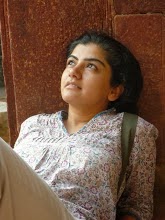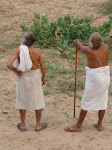


I imagine a day circa 1953. A reputed pathologist in an old, tradition-bound city sits patiently for hours in his laboratory, testing samples and writing reports. Once evening comes around he rushes to the ‘City Dramatics Society,’ where he changes his garb and takes on an altogether different role. The doctor also writes serious academic articles on topics stretching far beyond medicine, using over one hundred pseudonyms. He coordinates the activities of a curiously named literary club and religiously attends the musical mehfils (recitals) for which his city is renowned.
Then, as now, 89-year-old Dr. Bhanu Shankar Mehta of Varanasi has lived anything but a sterile medico’s life. His careers and passions read like a comprehensive list of college subjects: History, Maths, Biology, Drama, Geography, and Literature. In each one he’s excelled.
Born in 1921 in Jaunpur, Dr. Mehta’s arrival into this world was marked by a ‘100-gun salute’. His grandfather, the Superintendent of Police of Jaunpur district, ensured that the festivities marking his first grandchild’s birth befitted his own position as a ‘Sahab’. I could not help but smile when this octogenarian clad in a crisp white dhoti-kurta adds softly, “But I have no resonance of guns in me!”
We sit surrounded by a vast sea of books as Dr. Mehta recounts his lifetime of explorations. My thoughts drift away from the imagined echo of ‘a 100-gun salute’ to the well-known names I see on the books’ spines. It does not take long to figure out that Dr. Mehta spends most of his time in his study. He knows his sanctum well enough to fish out the right book each time he stretches out his hand.
Dr. Mehta’s life story soon begins to unfold before me there in his study. I picture his father, an erudite school teacher who had moved from Junagarh to Banaras to pursue Sanskrit studies in his adolescence. As a fatherless boy, living in Junagarh, Manilal Vaccharajaani saw an opportunity when Raja Munshi Madholal, a rich ‘Seth’ of Benaras announced a scholarship to deserving Indian boys who wished to pursue higher study. Manilal packed his bags and, like many other Gujarati compatriots of his time, set out to pursue opportunities in an unfamiliar territory. Finishing his Masters from the famous Sanskrit College and L.T from Allahabad University, Manilal Vaccharajani never returned back to Gujarat. He instead married the daughter of a ‘Sahab’, an I.P.S officer, and settled down in Banaras.
The Naagar Brahman community of Gujarat proudly distinguishes itself from other Brahman sub-castes. Naagars consider themselves progressive and endowed with artistic skill. Any Naagar would proudly tell you how the women in their community have equal rights as men. In true Naagar fashion, Manilal married the Kundan Kunwar
, daughter of a ‘Sipahi Naagar’ (the soldier-Brahmans from Gujarat who were in the service of Raja Chabilaram Farukhsiyar), in plain clothes and sans dowry. Class barriers are uncommon in the progressive world of Naagars. This marriage did not change Manilal’s decision to teach in a high school, where he would later become the headmaster. Two contrasting worlds – an austere father’s simple city house and the his maternal grandfather’s lavish garden house– fused easily in the young Dr. Mehta’s mind.
As Dr. Mehta recalls some impressions of his carefree early years in Banaras, I am reminded of just how much life in the city has changed. The sounds of generators, honking horns, and blaring televisions come in through the window, as I imagine the carefree days he describes, when young boys longed to watch ‘Ramleela’ weeks before it began every fall (The Kashi-Ramnagar Ramleelas were and continue to be an extravaganza). This was a time when you could spend long hours munching peanuts and watching the river Ganga flow by, while precariously perched on the railway track of the Dufferin Bridge. The Banaras of Dr. Mehta’s youth was free of plastic refuse and ubiquitous pollution. But life was not all footloose. The anti-British Sarkar movement was at an all-time high and our octogenarian, despite his middle-class upbringing, participated in it.
Dr. Mehta mentions that his grandfather, the man who earned the title of ‘Sahab’ during the Raj times, retired voluntarily from the police to serve the City Municipal Board in Varanasi. Despite his association with the British, ‘Sahab’ one evening unfurled the Indian flag atop the Municipal Board Office. Dr. Mehta emphasizes, ‘The people were not against the British, but against the system. We were not against the Goras or the White Race but against the discrimination. The freedom movement also brought with this an inner awakening; people began to question themselves about what freedom means to them personally and collectively as a nation.’
Following their seniors, young boys at Harishchandra High School, where Dr. Mehta studied, raised slogans like, ‘Ek, Do… Laal Pagdi Phenk Do!’ (Rhyming in Hindi as slogans do: ‘One, Two… Discard your Red Turbans!’). In junior school, Dr. Mehta wore a round cap (signifying his position) but by the time he graduated to Class V, he threw his cap in a bonfire. Dr. Mehta remembers the sad day when he read in the newspapers about Bhagat Singh’s death sentence. ‘I could not, and did not eat,’ he recounts. This inner exploration of freedom and its meaning continued with him till his college years in Lucknow, where he moved in 1940 to pursue higher education.
I am impatient to learn more about the next stage of his life in Lucknow, but Dr. Mehta does not wish to move on so quickly. He mulls over those years so long ago and starts speaking about his grandmother, who was his first teacher. Learning from her was organic. She had songs for every occasion and would sing religious and secular songs throughout the day while doing her daily chores. Another influence was his neighbor, Dr. Shobha Ram who also edited ‘Banaras Akhbar’. Dr. Shobha Ram’s spacious haveli was a world apart from his own home. Together with the neighbourhood children, Dr. Mehta enacted famous roles at Dr. Ram’s home, wrote simple scripts, designed costumes, and performed. ‘This is what we understood from ‘freedom’- To be able to express freely…’ School teachers, including Videshwar Banerjee, Pt. Kamlakar Cahubey, Sanjiva Rao and Chandi Prasad were not teachers but gurus. Each of them added unique dimensions to their students’ intellectual, artistic and spiritual journeys.
Determined to unravel the mysteries of human anatomy after high school, but unable to pass the qualifying exam, Dr. Mehta studied science at the under-graduate level but never lost his focus. He sat for the Medical School Exam after his under-graduation and moved on the next step of his journey. Seeing a satisfied look on my face after I scribble ‘Medical School’ on my notepad, he backtracks again. I am getting used to his method. He wants to pay a humble tribute. Retracing his steps, Dr. Mehta starts to speak about a man, his teacher, whose name I instantly recognize: Dr. Birbal Sahni, the famous paleontologist who taught science to the undergraduates at Lucknow University. “A thorough gentleman, Dr. Sahni was also a nationalist who did not mark us absent when we missed our class to participate in a protest against Vinobha Bhave’s arrest. He even congratulated us on the peaceful nature of our protest but when we requested him to repeat his lecture; he simply said that freedom also entailed sacrifice.” Dr. Mehta’s priceless possession is a certificate signed by Dr. Birbal Sahni declaring him a Bachelor of Science.
The Quit India movement coincided with the beginning of Dr. Mehta’s Medical College studies, and amidst arrests an
d a tense atmosphere the ‘Batch of 1947’ began its classes as late as January 1943. Despite a rigorous study schedule, the students participated in the freedom movement in their own ways. ‘We would hoist Indian flag atop the hostel buildings much to our teacher’s annoyance.’ Dr. Mehta was a good student and earned scholarships more than once during his medical college years but the college refused to promote him to M.D. The reason: indiscipline. Activities like hoisting the Indian flag, participation in protests, and open discussion on the freedom struggle earned him a bad reputation in the eyes of college authorities. ‘I apprenticed under the laboratory in-charge for a year and returned back to Varanasi,’ he says. ‘I borrowed Rs. 10,000 and travelled down to Bombay, purchased laboratory material and set up a pathology laboratory in Independent India.’ He received a formal degree in pathology almost a decade after starting his practice when he received a diploma in Clinical Pathology.

Marriage and children happened soon after medical college but Dr. Mehta’s creative explorations continued in the form of writing stories and plays, editing newspapers and acting on stage. ‘I moved from one genre to another, one medium to another in search of true expression.’ Today, Dr. Mehta has to his name about 40 books and hundreds of articles written or translated. He spent some of his quality time nourishing, the ‘Thalua Club’ (literally meaning the Idlers Club). The Thalua Club was symbolic of avant-garde expression in the field of literature and drama. For the club, Dr. Mehta organized seminars on theatre and acted, directed and even formally studied theatre. He presented programmes on the radio and lectured in person on cultural, medical and social issues.
Dr. Mehta went on to become a highly sought-after pathologist and practiced until 2004. He was actively associated with the Indian Medical Association, becoming its regional president and eventually was elected as a president of the All India Medical Association. As a president of the A.I.M.A, he travelled to Japan where he spent time interacting with the locals. The other delegates went out shopping and sightseeing but Dr. Mehta documented his experiences and informal interviews with the Japanese. On his return back, he published his experiences as ‘Yatra aur Yatra’ along with Leena Mangaldas (of Shreyas Foundation, Ahmedabad) who wrote a similar account on China. ‘These were pre-internet and cable television times. Any kind of account on an unknown corner was welcome by readers.’
Moving away from theatre to cultural studies was natural for Dr. Mehta. His vast knowledge on the tradition and performative aspects of Ramleela was the stepping stone. Dr. Mehta wrote and lectured on this subject and conducted research into unexplored aspects of Banaras’ rich cultural tradition. He put together the Banaras Gallery at Bharat Kala Bhavan, the University Museum at B.H.U. He is also credited with reviving an old and popular but forgotten festival (exclusive to 19th century Banaras), Burhva Mangal.
I ask him for his message to young people today. ‘Honesty and hard work, he says, ‘and to think out of the box. Going into the depth of your calling and passion is wonderful but to think out of the box and feel your calling along with hard work and honesty makes you yourself feel good.’ It’s a typical summer afternoon when I take his leave. A creaking ceiling fan cools the three lazing dogs, while Dr. Mehta fishes into his sea of books to read.


No comments:
Post a Comment